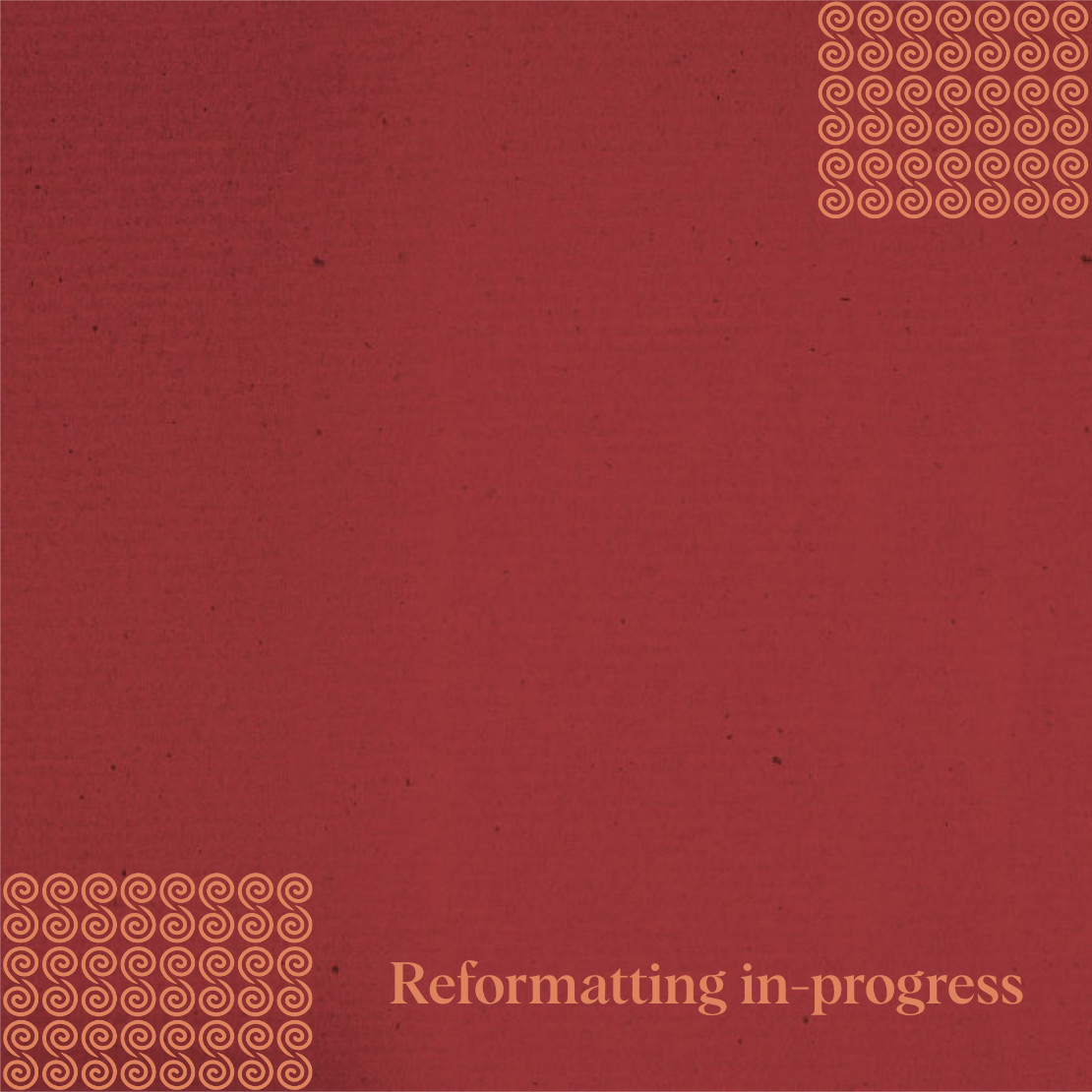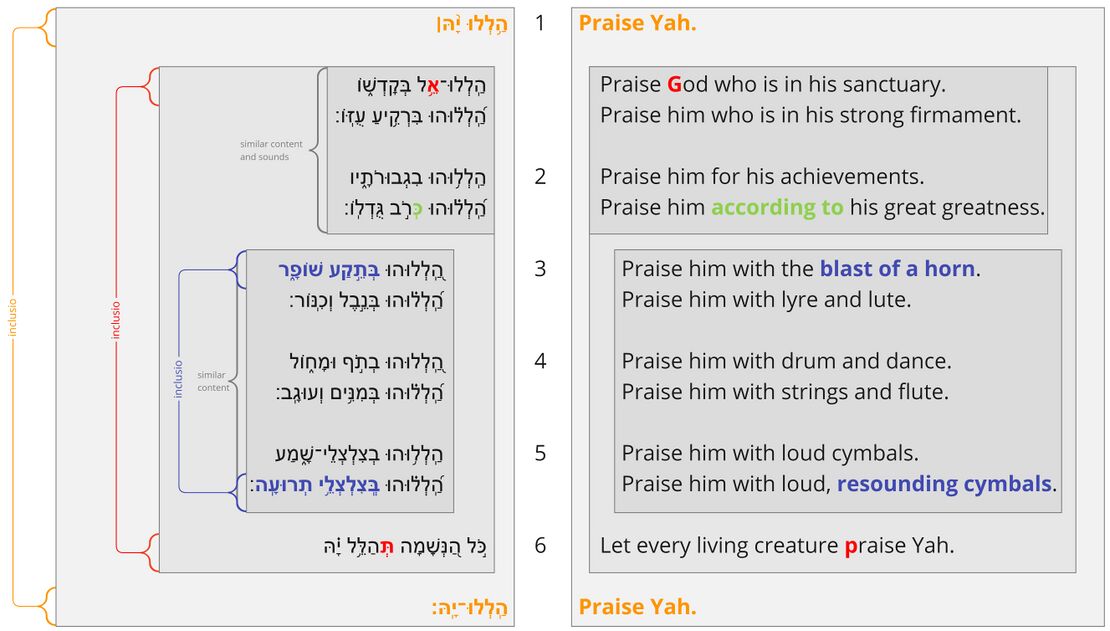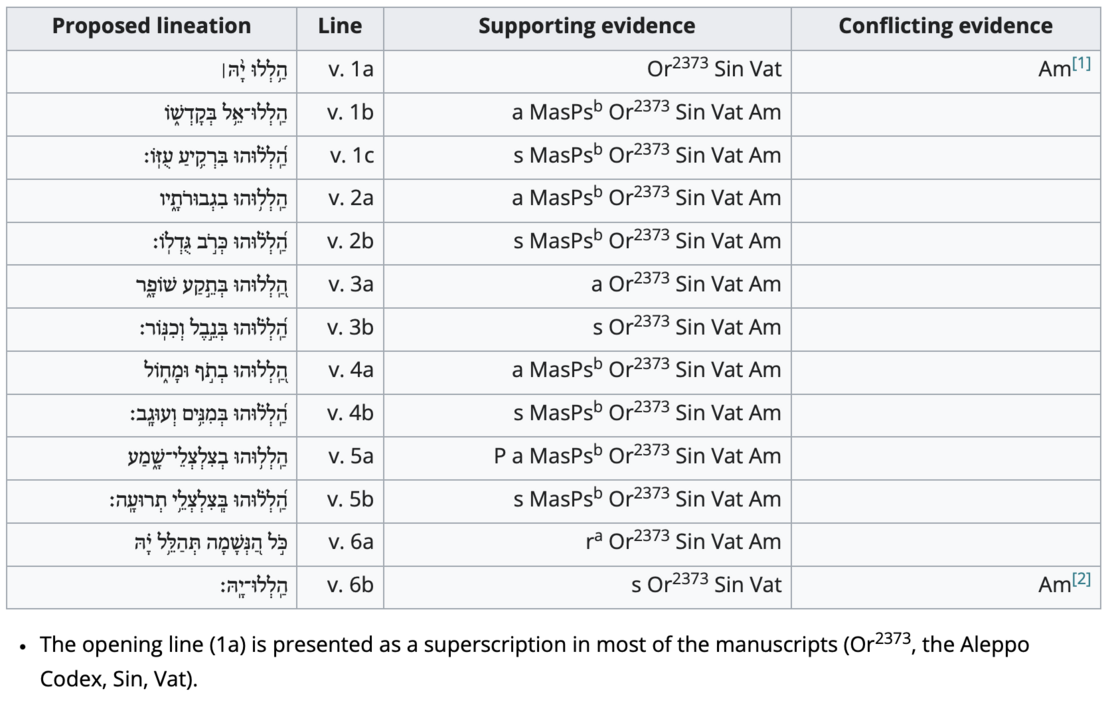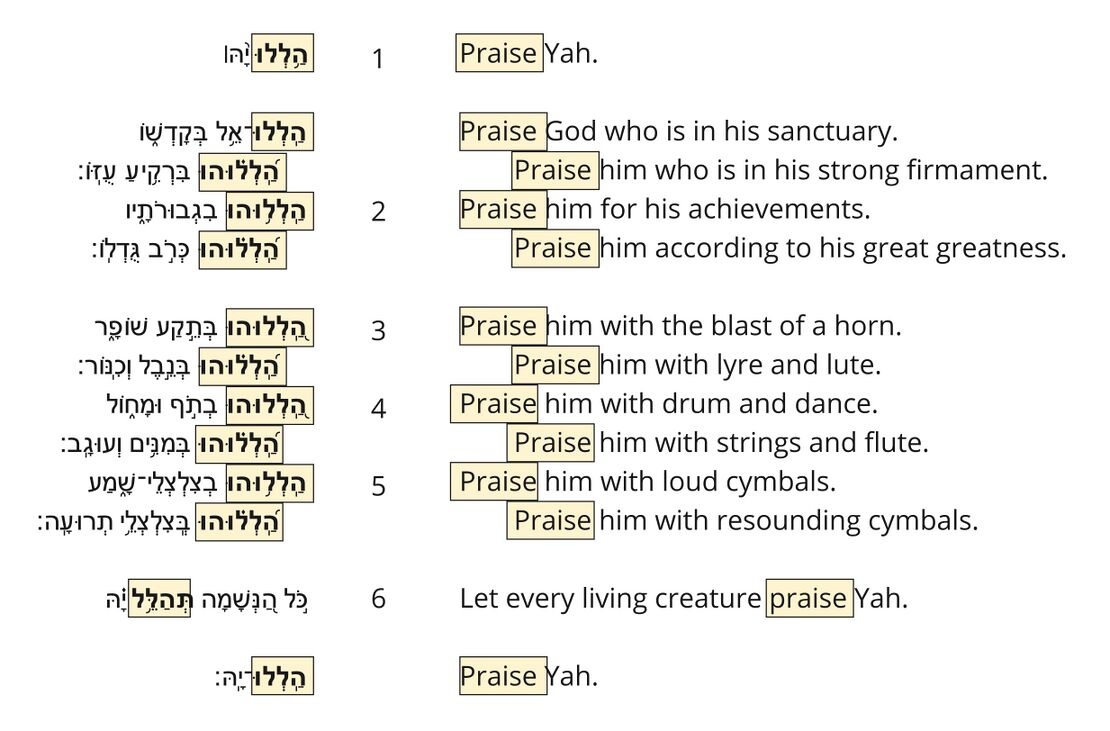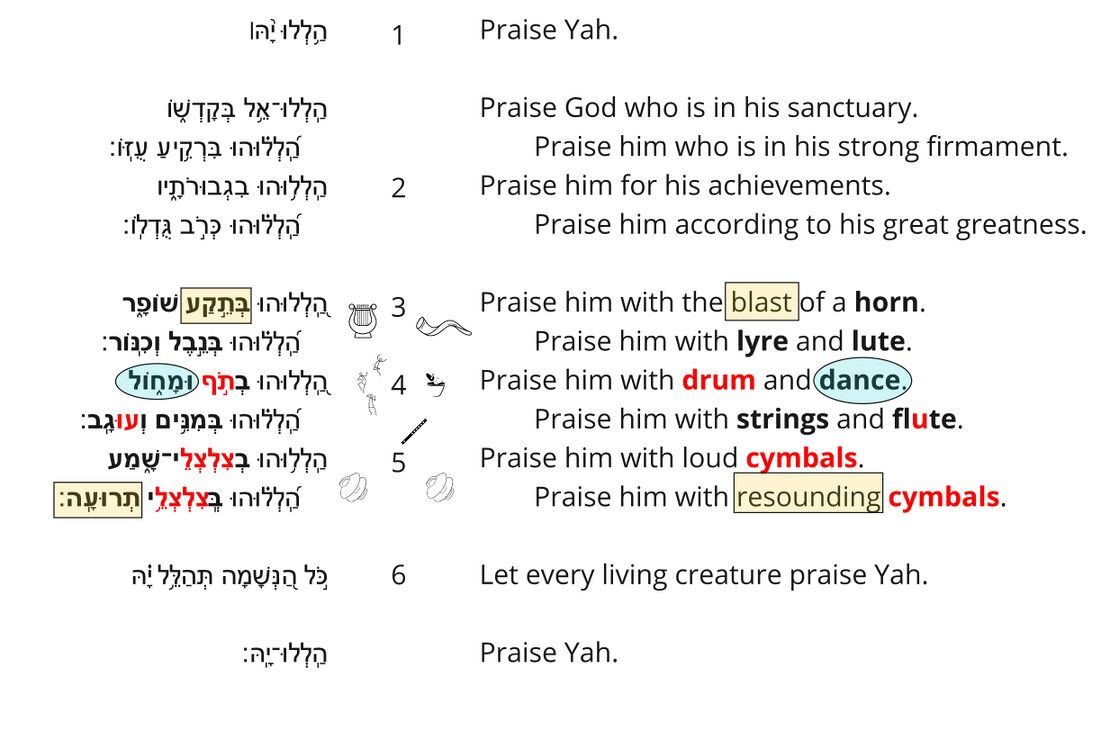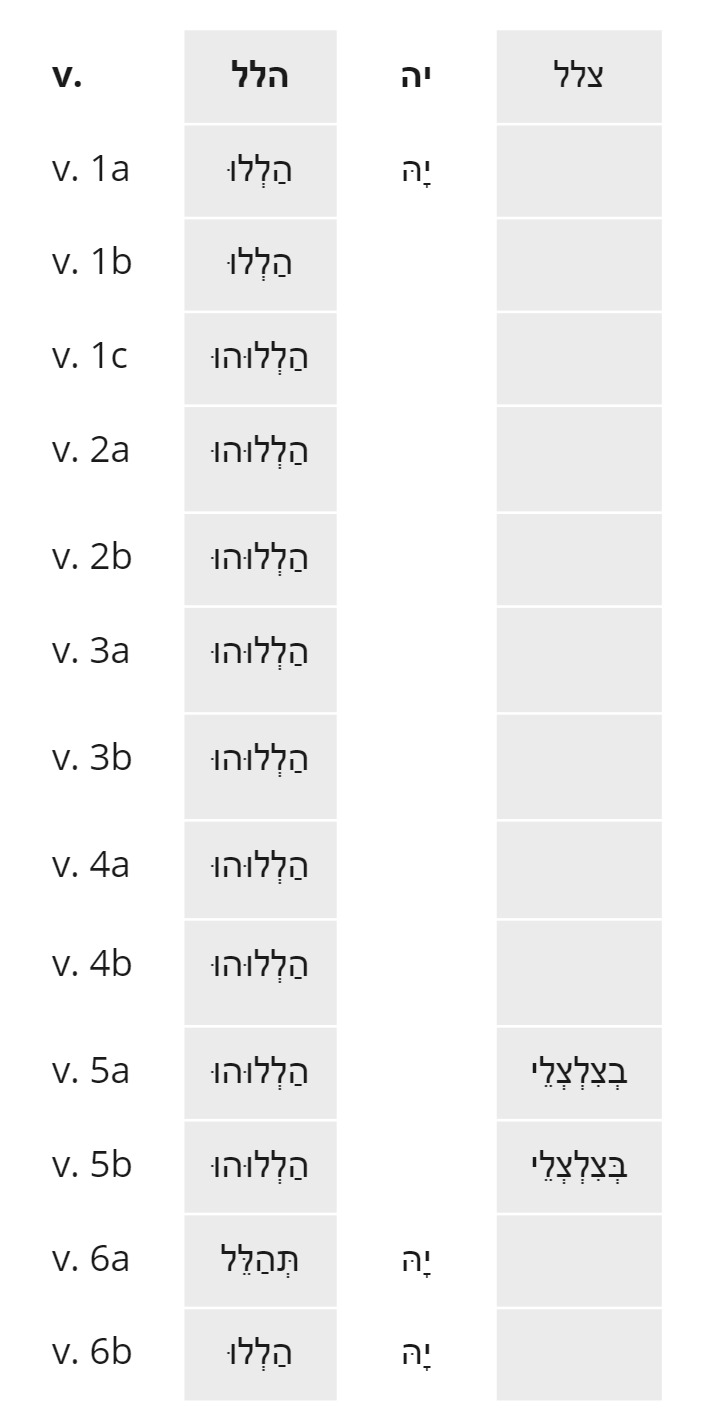Psalm 150 Poetry
About the Poetics Layer
Exploring the Psalms as poetry is crucial for understanding and experiencing the psalms and thus for faithfully translating them into another language. This layer is comprised of two main parts: Poetic Structure and Poetic Features.
Poetic Structure
In poetic structure, we analyse the structure of the psalm beginning at the most basic level of the structure: the line (also known as the “colon” or “hemistich”). Then, based on the perception of patterned similarities (and on the assumption that the whole psalm is structured hierarchically), we argue for the grouping of lines into verses, verses into sub-sections, sub-sections into larger sections, etc. Because patterned similarities might be of various kinds (syntactic, semantic, pragmatic, sonic) the analysis of poetic structure draws on all of the previous layers (especially the Discourse layer).
Poetic Macro-structure
Line Divisions
Poetic Features
In poetic features, we identify and describe the “Top 3 Poetic Features” for each Psalm. Poetic features might include intricate patterns (e.g., chiasms), long range correspondences across the psalm, evocative uses of imagery, sound-plays, allusions to other parts of the Bible, and various other features or combinations of features. For each poetic feature, we describe both the formal aspects of the feature and the poetic effect of the feature. We assume that there is no one-to-one correspondence between a feature’s formal aspects and its effect, and that similar forms might have very different effects depending on their contexts. The effect of a poetic feature is best determined (subjectively) by a thoughtful examination of the feature against the background of the psalm’s overall message and purpose.
Praise and Praise Alone
If an emendation or revocalization is preferred, that emendation or revocalization will be marked in the Hebrew text of all the visuals.
| Emendations/Revocalizations legend | |
|---|---|
| *Emended text* | Emended text, text in which the consonants differ from the consonants of the Masoretic text, is indicated by blue asterisks on either side of the emendation. |
| *Revocalized text* | Revocalized text, text in which only the vowels differ from the vowels of the Masoretic text, is indicated by purple asterisks on either side of the revocalization. |
Feature
The psalm is characterised by extreme repetition. The only verb in the psalm is "praise" (x13), and every clause (except for v. 6a) has the same grammatical structure (IMPV + PP) with its constituents in the same order.
Effect
Everything is muted compared to the resounding "praise him!" This embodies the idea that everything should be oriented to one goal: praising YHWH.
Poetic Party
If an emendation or revocalization is preferred, that emendation or revocalization will be marked in the Hebrew text of all the visuals.
| Emendations/Revocalizations legend | |
|---|---|
| *Emended text* | Emended text, text in which the consonants differ from the consonants of the Masoretic text, is indicated by blue asterisks on either side of the emendation. |
| *Revocalized text* | Revocalized text, text in which only the vowels differ from the vowels of the Masoretic text, is indicated by purple asterisks on either side of the revocalization. |
Feature
Vv. 3-5 are distinguished by the listing of eight instruments.
The first of these, the "horn", was used to signal important events. The word that closes the section ("shout") is closely associated with the horn, and, like the horn, was also used to signal important events. The word "dancing" is the middle word of this section (8-1-8), and it is surrounded by four instruments on either side. Several of the names for these instruments are onomatopoetic. "Tof" (drum) sounds like the striking of a drum, "u" (in "ugab") like the sound of a wind instrument, and "ts-ts" like the crashing of cymbals. The cymbals are the loudest (both in terms of the instrument and the word itself), and they are repeated at the end.
Effect
Verses 3-5 are not just a call to celebrate; they embody a musical celebration in miniature, commencing with a "horn blast" (cf. 1 Kgs. 1:39-41), concluding with a "shout," and with a victory dance in the middle. The two crashes of the "tsiltsilim" at the end bring the celebration to a climax finish.
Overflowing Praise
If an emendation or revocalization is preferred, that emendation or revocalization will be marked in the Hebrew text of all the visuals.
| Emendations/Revocalizations legend | |
|---|---|
| *Emended text* | Emended text, text in which the consonants differ from the consonants of the Masoretic text, is indicated by blue asterisks on either side of the emendation. |
| *Revocalized text* | Revocalized text, text in which only the vowels differ from the vowels of the Masoretic text, is indicated by purple asterisks on either side of the revocalization. |
Feature
The psalm begins, after the opening hallelujah, with the word "God", which begins with alef, the first word of the Hebrew alphabet. The psalm ends with the words "let [them] praise Yah," which begin with tav, the last letter of the alphabet. The words "Praise Yah. Praise... Yah. Praise Yah" occur outside of the boundaries set by the alef and tav.
Effect
The alphabet is a symbol of completeness. By starting with "A" and ending with "Z," Psalm 150 not only marks the completion of the Psalter, it is also a fitting psalm for praising him who is "the alpha and the omega, the first and the last," whose reign is universal (v. 2) and to whom "all living creatures" owe praise (v. 6). Yet even the alphabet cannot contain his praise, as the words "Praise Yah" (x3, also a symbol of completeness) overflow outside of the alphabet's boundaries.
Repeated Roots
The repeated roots table is intended to identify the roots which are repeated in the psalm.
| Repeated Roots legend | |
|---|---|
| Divine name | The divine name is indicated by bold purple text. |
| Roots bounding a section | Roots bounding a section, appearing in the first and last verse of a section, are indicated by bold red text. |
| Roots occurring primarily in the first section are indicated in a yellow box. | |
| Roots occurring primarily in the third section are indicated in a blue box. | |
| Roots connected across sections are indicated by a vertical gray line connecting the roots. | |
| Section boundaries are indicated by a horizontal black line across the chart. | |
Bibliography
